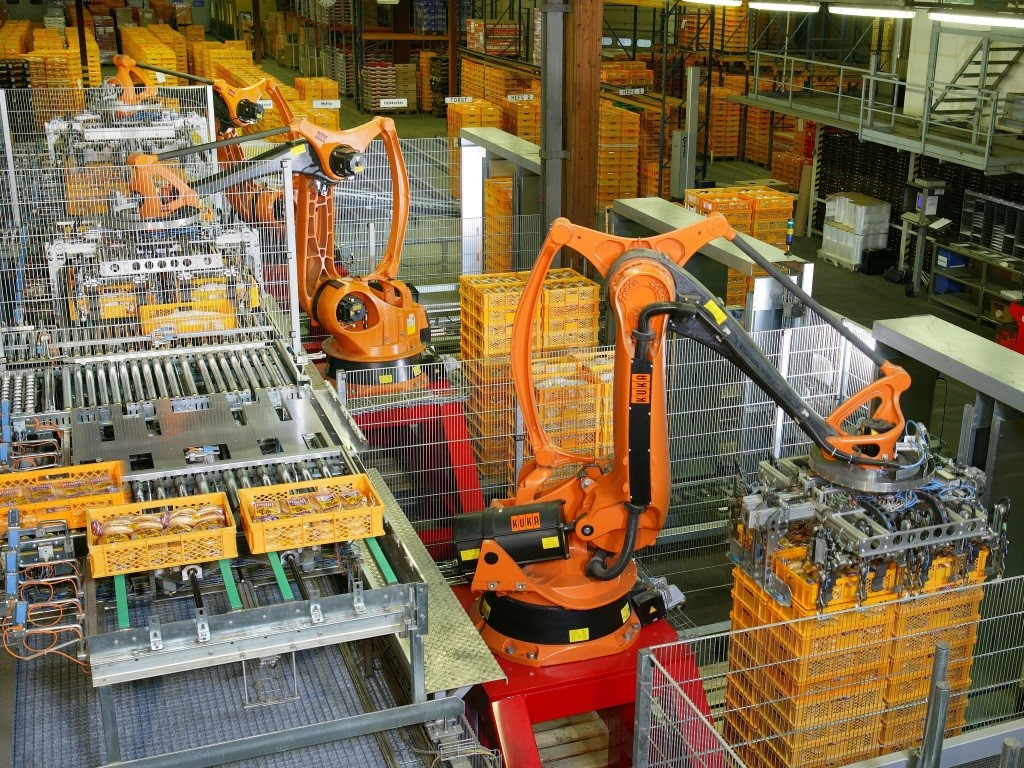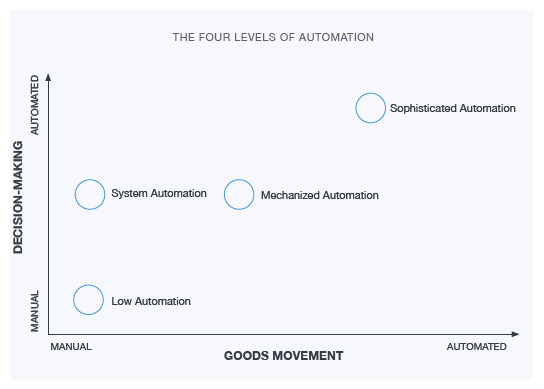The 4 Levels of Warehouse Automation

In a previous article we looked at 3 drivers behind the trend toward automation in warehousing. A White Paper published by Westernacher Consulting titled ‘The Trends Toward Warehouse Automation’ outlines 4 levels of automation that are possible to meet the trends.
1. Low Automation
This level of automation is usually found in warehouses with more basic inventory recording systems incorporating printed papers. Decisions on where products need to be placed and which container bin they are replenished from can be hinted by the system while workers on the floor make the detailed decisions. In this system workers usually need to travel long distances to put away and pick goods.
2. System Automation
The next level is a Warehouse Management System which makes decisions on where to put away/pick items and manage other processes like deconsolidation, Value Added Services and quality inspection. The system also knows when to handle these things and who should perform the tasks. The system adopts technologies such as Mobile Radio Frequency or Voice Directed Technologies to confirm and send stock information to the Warehouse Management System in real time.
The majority of companies observe around a 25% gain in overall productivity, a 10-20% improvement in space utilization, and a 15-30% reduction in safety stock when moving from a paper-based system to this level of automation.
By adopting a Warehouse Management System you are also able to leverage other technologies for picking orders. One example is Pick-by-light which uses rows of lights above bins to show workers where, what and how many to pick. This makes the whole picking process move a lot faster and is more accurate for multi-order picks.
According to Statistics published by the Material Handling Institute, pick-to-light systems can improve pick rate by 30-50 %. In addition, they reduce picking error rate by 67% compared to a paper based system.

Image Source: Westernacher Consulting titled ‘The Trends Toward Warehouse Automation’ by Westernacher Consulting
3. Mechanized Automation
At this level of automation we start to see a reduction in the distances travelled by workers. Automated systems are implemented which transport the goods to the worker for packing. There are two kinds of technologies that allow this to happen.
Conveyors
Using conveyors reduces travel distances and significantly improves pick rate. Typically, a worker can do 60 to 80 picks an hour, but using conveyors can deliver up to 300 picks per hour.
Automated Storage and Retrieval System (AS/RS)
An AS/RS system typically solves two of the biggest issues warehouses face: space utilization and accessibility. Aisle widths can be significantly reduced and storage space can stack further upwards. The AS/RS system runs on a network of cranes, lifts and shuttles which are all linked into the Warehouse Management System. Items are picked and fed onto a conveyor belt system for workers to fulfill orders and manage the workflow.
4. Sophisticated Automation
At the highest level of automation, automated equipment is used to eliminate manual movements and streamline order-picking processes. The system handles complex decision-making and relies extensively on the use of pallet and case conveyors, as well as some of the following other technologies.
Automatic Sorters
Automatic Sorters identify, transport and group cases into orders they belong to. Sorters can control the flow of goods by using pop-up wheels, while others may use tilting trays or sectional conveyors.
AGV: Automated Guided Vehicle
You’ve probably seen these robotic vehicles in the media. They are the autonomous vehicles that resemble larger versions of the automated floor cleaning robots you can buy for your home. They are equipped with visual sensors and smart programming that allows them to transport goods around the warehouse and charge themselves by returning automatically to recharging stations when power is low.
Robotic Picking System
Robotic Picking Systems handle smaller item picks. They scan and identify items in containers, then pick them into corresponding totes and packages. They require a high level of precision and are the frontiers of warehouse automation.
Automatic Palletizer
After picking, orders are then stacked onto pallets by an automated palletizer. Using algorithms the palletizer can work out the optimal way to stack items to make best use of the space available.
If you’d like further information on TUMA sliding systems suitable for warehouse automation, please contact us.
Warehouse Automation Slides
Back


